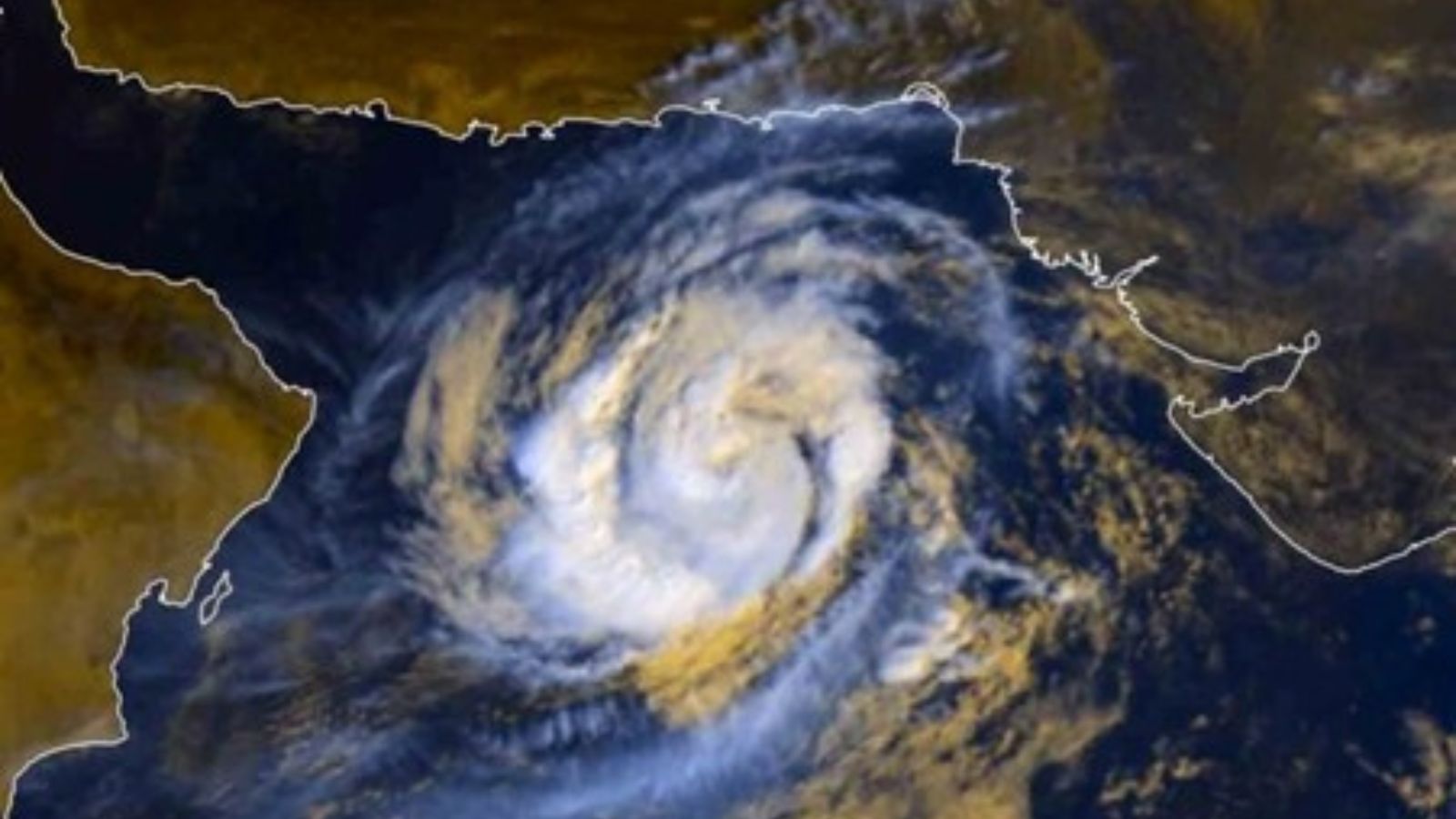Overview of Cyclone Shakti
The India Meteorological Department (IMD) has issued updated weather warnings on Cyclone Shakti, which formed over the west-central and adjoining northwest Arabian Sea. As of Tuesday (07 October), the system has moved south-southeastwards at a speed of approximately 8 kmph, carrying maximum sustained winds of 25 knots (46 kmph) and gusts up to 30 knots (55 kmph).
The storm’s center was located around:
- 230 km southeast of Masirah (Oman)
- 360 km south of Ras Al Hadd (Oman)
- 960 km southwest of Karachi (Pakistan)
- 980 km west-southwest of Dwarka (India)
- 1,000 km west-southwest of Naliya (India)
According to IMD projections, Cyclone Shakti in Arabian Sea is expected to gradually weaken into a depression within the next few hours as it continues its slow east-southeastward drift.
Forecast and Current Weather Conditions
The IMD reported squally winds reaching 50–60 kmph, gusting up to 70 kmph, over the west-central Arabian Sea, with speeds expected to gradually decline to 45–55 kmph by Tuesday evening. Sea conditions remain very rough to rough, posing significant risks to fishing vessels and small boats.
The estimated central pressure of the system stands at 1000 hPa, signaling moderate intensity. Fishermen have been advised not to venture into the Arabian Sea due to turbulent conditions and strong winds.
The Cyclone Shakti in Arabian Sea advisory covers coastal districts of Maharashtra, Gujarat, and Sindh, where authorities are monitoring potential heavy rainfall, strong winds, and localized flooding.
Impact on Coastal Regions
The influence of Cyclone Shakti is expected to be felt most strongly across coastal Maharashtra, Gujarat, and Sindh, with impacts ranging from severe rainfall to high tidal waves and temporary power outages.
- Marine Operations: Rough seas and strong winds are disrupting fishing, shipping, and port activities.
- Infrastructure: Flash floods and waterlogging could affect highways, railway lines, and low-lying settlements.
- Utilities: The combination of high winds and heavy rainfall may lead to power cuts and communication disruptions.
- Transport: Air travel delays are anticipated at Mumbai, Porbandar, and Karachi airports due to poor visibility and gusty conditions.
Local administrations have placed disaster management and emergency response teams on standby. Residents have been advised to remain indoors and avoid venturing near coastal areas.
Regional Implications of Cyclone Shakti in Arabian Sea
While Cyclone Shakti in Arabian Sea is likely to weaken over the next 24 hours, its lingering effects could persist for up to two days. The system’s path may continue to influence the western Indian coastline and parts of southern Pakistan, with moderate to heavy rainfall expected even after dissipation.
The event underscores the rising frequency of late-season cyclonic activity in the Arabian Sea, attributed to warmer sea surface temperatures and changing monsoon dynamics. Meteorological experts have emphasized the need for improved coastal preparedness and early warning dissemination systems to reduce the long-term impact of such storms.
Recommendations
- For Coastal Residents: Avoid sea travel, beach areas, and open coastal zones until conditions stabilize.
- For Fishermen: Heed IMD advisories and stay clear of the west-central Arabian Sea until the cyclone weakens.
- For Travelers: Monitor airline and port advisories; plan for potential delays or cancellations.
- For Businesses and Industries: Secure outdoor assets, review supply chain contingencies, and prepare for short-term logistical delays.
- For Emergency Services: Maintain high alert status across Maharashtra, Gujarat, and Sindh, focusing on vulnerable coastal districts.
Key official sources for monitoring updates include:
Conclusion
The emergence of Cyclone Shakti in Arabian Sea reinforces the need for continued vigilance across South Asia’s coastal zones. Although the system is forecast to weaken, rough seas, strong winds, and heavy rainfall continue to pose significant risks to both coastal populations and maritime operations.
Authorities across Maharashtra, Gujarat, and Sindh are maintaining heightened preparedness levels, emphasizing precautionary measures and timely communication. As the monsoon season transitions toward its final phase, the experience of Cyclone Shakti highlights the growing importance of climate resilience and early warning systems in safeguarding coastal communities.
Stay Ahead of Threats with Datasurfr Predict
MitKat’s Datasurfr Predict delivers accurate, real-time, and contextualised data to help organisations respond swiftly to physical, environmental, and cyber threats.
With Sam AI, our AI Agent not only provides context for unfolding events but also analyses vetted historical data to forecast how events are likely to evolve and their potential impact using industry and location-specific probabilistic scores.
Book a free demo today and see how Datasurfr Predict can transform your risk preparedness.


